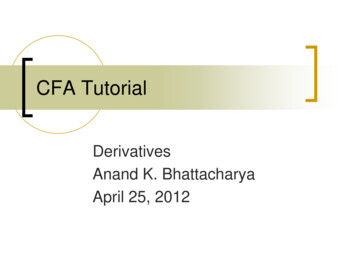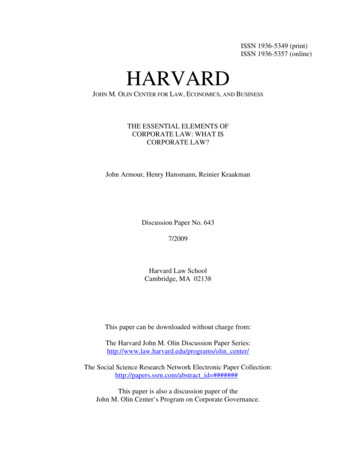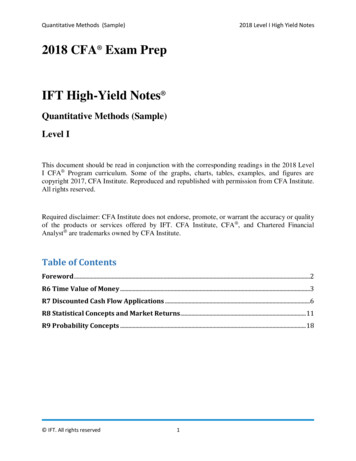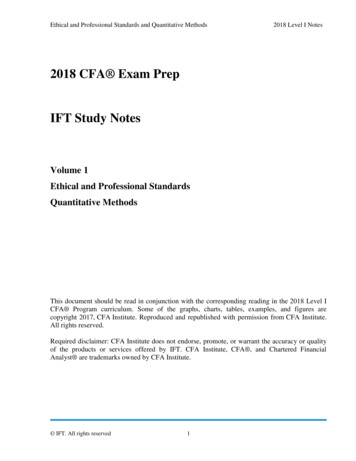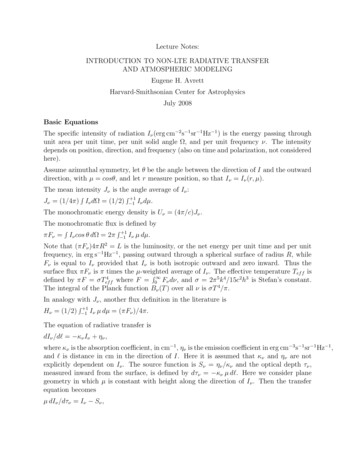
Transcription
Lecture Notes:INTRODUCTION TO NON-LTE RADIATIVE TRANSFERAND ATMOSPHERIC MODELINGEugene H. AvrettHarvard-Smithsonian Center for AstrophysicsJuly 2008Basic EquationsThe specific intensity of radiation Iν (erg cm 2 s 1 sr 1 Hz 1 ) is the energy passing throughunit area per unit time, per unit solid angle Ω, and per unit frequency ν. The intensitydepends on position, direction, and frequency (also on time and polarization, not consideredhere).Assume azimuthal symmetry, let θ be the angle between the direction of I and the outwarddirection, with µ cosθ, and let r measure position, so that Iν Iν (r, µ).The mean intensity Jν is the angle average of Iν :Jν (1/4π) Iν dΩ (1/2)RR 1 1Iν dµ.The monochromatic energy density is Uν (4π/c)Jν .The monochromatic flux is defined byπFν Iν cos θ dΩ 2πRR 1 1Iν µ dµ.Note that (πFν )4πR2 L is the luminosity, or the net energy per unit time and per unitfrequency, in erg s 1 Hz 1 , passing outward through a spherical surface of radius R, whileFν is equal to Iν provided that Iν is both isotropic outward and zero inward. Thus thesurface flux πFν is π times the µ-weightedaverage of Iν . The effective temperature Tef f isR 4defined by πF σTef f where F 0 Fν dν, and σ 2π 5 k 4 /15c2 h3 is Stefan’s constant.The integral of the Planck function Bν (T ) over all ν is σT 4 /π.In analogy with Jν , another flux definition in the literature isHν (1/2)R 1 1Iν µ dµ (πFν )/4π.The equation of radiative transfer isdIν /d κν Iν ην ,where κν is the absorption coefficient, in cm 1 , ην is the emission coefficient in erg cm 3 s 1 sr 1 Hz 1 ,and is distance in cm in the direction of I. Here it is assumed that κν and ην are notexplicitly dependent on Iν . The source function is Sν ην /κν and the optical depth τν ,measured inward from the surface, is defined by dτν κν µ d . Here we consider planegeometry in which µ is constant with height along the direction of Iν . Then the transferequation becomesµ dIν /dτν Iν Sν ,
-2where τν at a given depth is the integral of κν along the inward normal from the surfaceto the given depth. Often κν is expressed as κν ρkν where ρ is the gas density in g cm 3and kν is the mass absorption coefficient in cm2 g 1 . We can integrate the transfer equationover µ to obtain dHν /dτ Jν Sν .The transfer equation has the following formal solution, where, for simplicity, we omit thefrequency subscript. The intensity at a given value of τ in the inward direction (µ 0) isgiven byI(τ, µ) I(0, µ)eτ /µ (1/µ)Rτ0e(τ t)/µ S(t)dt,where I(0, µ) is any given incident intensity at the τ 0 boundary. In the outward direction(µ 0) the solution isI(τ, µ) I(τm , µ)e (τm τ )/µ (1/µ)R τmτe (t τ )/µ S(t)dt,where I(τm , µ) is any given incident intensity at an inner boundary where τ τm . In thecase of a semi-infinite atmosphere the first term is zero provided that I(τm , µ) does notincrease exponentially. Thus for µ 0,I(τ, µ) (1/µ)R τe (t τ )/µ S(t)dt.The emergent intensity in this semi-infinite case isI(0, µ) (1/µ)R 0e t/µ S(t)dt, for µ 0.If S is a linear function of t it is easily shown that I(0, µ) S(τ µ). This is called theEddington-Barbier relation.We can use these equations for I(τ, µ) to express the mean intensity J(τ ) as an integralover the source function S(t). This involves the first exponential integralE1 (x) R x(1/y)e y dywhich behaves as (1/x)e x at large x and as -log x as x approaches 0. Apart from incidentradiation terms, the result isJ(τ ) (1/2)R τm0E1 ( t τ )S(t)dt.This equation is often written asJ(τ ) Λ{S}, where Λ is called the Lambda operator.The E1 function has the property 0 E1 (t)dt 1 so that when S is constant in the semiinfinite case with no incident radiation, J S at large τ , and J (1/2)S at the surface.RThe flux quantity H defined above depends on the source function according toH(τ ) (1/2) 0τm E2 ( t τ )sgn(t τ )S(t)dt, where sgn(t τ ) is the sign of (t τ ), andE2 is the second exponential integralRE2 (x) R x(1/y 2 )e y dy.
-3This equation for H is often written as H(τ ) Φ{S}, where Φ is called the Phi operator.RThe E2 function has the property 0 E2 (t)dt 1/2 so that when S is constant in thesemi-infinite case with no incident radiation, H 0 at large τ , and H (1/4)S at thesurface. Another property of the flux equation is that if S(τ ) C0 C1 τ where C0 and C1are constants, then H approaches (1/3)C1 at large τ .Within an enclosure in thermodynamic equilibrium at temperature T , the intensity Iν isisotropic and equal to the Planck functionBν (T ) (2hν 3 /c2 )[ehν/kT 1] 1 in erg cm 2 s 1 sr 1 Hz 1 .Also, all particles have Maxwellian velocity distributions, excitations are governed by theBoltzmann equation, and ionizations by the Saha-Boltzmann equation (both equationsgiven later), all at the same temperature T .Local thermodynamic equilibrium (LTE) refers to the assumption that velocities, excitations, and ionizations are all in equilibrium corresponding to the local temperature, whichmay vary with depth in the medium. In general this means that Sν Bν at each depth,but the intensity Iν must be calculated from the transfer equation with Sν Bν . LTE isa good approximation at sufficiently large optical depths such as in stellar photospheres atcontinuum frequencies or in relatively weak lines. Here we discuss general non-LTE case inwhich Sν 6 Bν , which includes the special case of LTE.Monochromatic ScatteringIf every photon encountering an atom (or an electron) is scattered isotropically with nochange in frequency (or if this is the net effect of successive scatterings), then Sν Jν . Wecan consider a combination of LTE and scattering by writing the transfer equation asdI/d κab (I B) κsc (I J)where the frequency subscript has been omitted for simplicity.Let dτ (κab κsc )µd and κab /(κab κsc ). ThenµdI/dτ I S where S (1 )J B.In this last equation we can introduce the Lambda operator, given above, and writeS (1 )Λ{S} B.To demonstrate some simple solutionsof this equation we replace the E1 (x) function by 3xso that we have the integral equationthe first-order approximation 3e R S(τ ) (1 ) 0 ( 3/2)e 3 t τ S(t)dt Bin the semi-infinite case with no incident radiation. This equation has the following solutionwhen and B are constant: S(τ ) B[1 (1 )e 3 τ ] as can be verified by substitution. This result shows that 1) S(0) B, and 2) for 1,S approaches B only for τ 1/ , which is referred to in this case as the thermalizationdepth.
-4These two results illustrate the physical nature of the scattering process. The parameter is small when a photon is much more likely to be scattered than thermally absorbed, eventhough LTE is assumed for the absorption. Such scattering decouples S from B so that thephotons escaping through the boundary effectively originate deep in the atmosphere ratherthan at τ of order unity. This is the case of simple monochromatic scattering, but a verysimilar interpretation applies to photons in a spectral line as described in the next section.The thermalization depth is 1/ for monochromatic scattering, but, as discussed in thenext section, is 1/ in the case of scattering in a line with complete frequency redistribution,i.e., with a common frequency probability for both absorption and emission within the line.Line RadiationIn the case of line radiation, the Einstein coefficient A21 represents the number of spontaneous radiative transitions from the upper atomic level 2 to the lower level 1, per atom inlevel 2, per unit time.B12 J is the number of transitions from 1 to 2 due to the absorption of line radiation, perRatom in level 1, per unit time. Here J 0 Jν φν dν, where Jν is the mean intensity of lineradiation and φν is the line profile function (the probability within Rthe line of an absorptionor of an emission, here considered the same) normalized so that 0 φν dν 1. This rateis proportional, through J , to the number of available photons that can cause the 1 to 2transition.B21 J is the number of 2 to 1 radiative transitions stimulated by radiation at line frequencies.(In this case the emitted photon travels in the same direction as the one causing theemission, as in a laser, but this property does not affect the development here.)n1 and n2 are the number densities (level populations) in cm 3 for levels 1 and 2.n2 (A21 B21 J) equals the number of downward radiative transitions (cm 3 s 1 ).n1 B12 J equals the number of upward radiative transitions (cm 3 s 1 ) resulting from theabsorption of photons.A21 , B21 , and B12 are the Einstein coefficients for spontaneous emission, stimulated emission, and absorption.If these transitions are the only effective ones (i.e., no collisions), then in a steady state,i.e., in statistical equilibrium, we have n2 (A21 B21 J) n1 B12 J.This equation allows us to derive relationships between the Einstein coefficients.In thermodynamic equilibrium J is equal to the Planck function Bν at the line frequencyν (which is essentially constant throughout the line), and n2 /n1 n 2 /n 1 where this equilibrium ratio is given by the Boltzmann equation n 2 /n 1 (g2 /g1 )e hν/kT . Here g1 and g2are the statistical weights of levels 1 and 2, so that n 2 (A21 B21 Bν ) n 1 B12 Bν . Solvingthis equation for Bν givesBν (A21 /B21 )[ehν/kT (g1 B12 /g2 B21 ) 1] 1 .
-5Since the Einstein coefficients and the statistical weights are independent of T it followsthatA21 /B21 2hν 3 /c2 and g1 B12 g2 B21 .Now suppose there are collisional transitions between levels 1 and 2 in addition to theradiative transitions. Let n2 C21 and n1 C12 be, respectively, the number of downward andupward collisional transitions per unit volume and time (cm 3 s 1 ). These collision rateswill depend on temperature and will be proportional to the number density of particlesinducing the collisional transition, usually the electron number density.The statistical equilibrium equation with both radiative and collisional transitions is thenn2 (A21 B21 J C21 ) n1 (B12 J C12 ).Since C21 and C12 are independent of n2 , n1 , and J, we can consider the case of thermodynamic equilibrium, so that the radiative terms drop out, and we obtain the relationshipn 2 C21 n 1 C12 between the downward and upward collision rates. This relationship assumes that the particle velocities have Maxwellian distributions. When n2 /n1 n 2 /n 1 , thetwo levels are said to be in detailed balance.We will return to this statistical equilibrium equation after first considering line absorptionand emission in the radiative transfer equation.Here we assume that the normalized profile function φν represents the probability that aphoton is emitted at a given frequency ν within a given line, as well as the probability thata photon is absorbed at frequency ν within the line. In the simple case of only thermalDoppler broadening due to a Maxwellian distributionof velocities, with negligible intrinsic 1 [(ν ν20 )/ νD ]whereν0 is the line centerline broadening, φν is given by φν ( νD π) eqfrequency and νD is the thermal doppler width νD (ν0 /c) 2kT /ma , in which ma isthe mass of the atoms that absorb and re-emit the line radiation.This use of the same φν for absorption and emission is the case of complete redistribution.In the more general case of partial redistribution, the frequency of an emitted photon iscorrelated with that of the absorbed photon that caused the atomic excitation. See Hubeny,I. & Lites, B. W. 1995, Partial redistribution in multilevel atoms. I. Method and applicationto the solar hydrogen line formation, ApJ, 455, 376, and the Appendix in Avrett, E. H. &Loeser, R. 2008, Models of the solar chromosphere and transition region from SUMER andHRTS observations: Formation of the extreme-ultraviolet spectrum for hydrogen, carbon,and oxygen, ApJS, 175, 229.The number of spontaneous photon emissions per unit volume, time, and frequency isn2 A21 φν . Since each emission contributes energy hν distributed over solid angle 4π, theemission coefficient is ην (hν/4π)n2 A21 φν . The line absorption coefficient is similarly κν (hν/4π)n1 B12 φν such that κν Iν is the absorbed energy in the units erg cm 3 s 1 sr 1 Hz 1 .The stimulated emission term in the same units is (hν/4π)n2 B21 φν Iν .The stimulated emission and aborption terms can be combined (since both are proportionalto Iν ), finally giving the line transfer equation
-6dIν /d (hν/4π)φν [(n1 B12 n2 B21 )Iν n2 A21 ].This equation can be put in the form considered earlier, i.e.,µdIν /dτν Iν Sνby defining the monochromatic optical depth dτν κν µd in terms of the line absorptioncoefficientκν (hν/4π)(n1 B12 n2 B21 )φν (hν/4π)n1 B12 [1 (n2 g1 /n1 g2 )]φν ,and with the source function given bySν (2hν 3 /c2 )[(n1 g2 /n2 g1 ) 1] 1which is equal to the Planck function when n2 /n1 n 2 /n 1 .Note that in this case of complete redistribution, S does not depend on φν and is essentiallyfrequency independent over the bandwidth of the line.Now we return to the statistical equilibrium equation which expresses n2 /n1 in terms of J,the collision rates, and the Einstein coefficients. Substituting this ratio into the equationfor S gives the resultS (J εB)/(1 ε),whereε (C21 /A21 )(1 e hν/kT ),thus writing the statistical equilibrium equation as an equation for the line source function.Using the notation ε/(1 ε), this equation for S becomesS (1 )J B,which has the same form as the earlier expression in the case of coherent scattering togetherwith thermal absorption and emission, except that JRν in the earlier expression now becomesthe line-integrated function J. Combining J 0 Jν φν dν with Jν Λ{S} from thetransfer equation gives, in the semi-infinite case,J R 0K( t τ )S(t)dt where K(p) This function has the normalizationR 0R 0φ2ν E1 (φν p)dν.K(p)dp 1/2.Two-Level-Atom SolutionsWe n
Lecture Notes: INTRODUCTION TO NON-LTE RADIATIVE TRANSFER AND ATMOSPHERIC MODELING Eugene H. Avrett Harvard-Smithsonian Center for Astrophysics July 2008 Basic Equations The speci c intensity of radiation I (ergcm 2s 1sr 1Hz 1) is the energy passing through unit area per unit time, per unit solid angle , and per unit frequency . The intensity depends onposition, direction,

